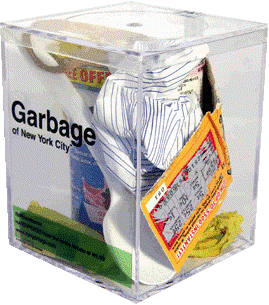
(from NYC Garbage)
Unlike Mr. Gignac, who has been capable of assembling trash in a fascinating way, by putting it into a cube gives a consistent vision to an apparently chaotic set, financial data (as well as many other things in our ordinary life) work in a completely different way.
The evaluation of the overall performance of any CPM system often relies on the quality of the set of information which feeds those systems. And even though the main architecture of a database (in terms of items and hierarchies) may be designed following the best practices of the industry, data entry activities which follow may reflect the importance of the human factor in the interaction between man and machine. In this article I will try to give a consistent vision to apparently chaotic pieces of advice generated by my experience as consolidation specialist in the past 10 years. Ten years in ten key points.
The aim is to build an information flow that fits the reporting needs of a company as well as the requirements of the system, in order to obtain the right information on time with the minimum spent in terms of human and corporate resources.

1. DON’T BLAME THE SYSTEM. BLAME YOURSELF.
Many of us often complain that the software we use for our business is too slow and it’s not performing as it should (well, at least, not as well as the vendor promised). As we will see in the next sections, you should not blame the software itself. Think about how your laptop was performing when you first bought it. Were you happy with it? Then what happened? Hardware hasn’t changed. But meanwhile you agreed to upgrade your software, using for example a new version of Excel to do exactly the same things as you were doing before.
Data flows work exactly in the same way. If you start with a lean and consistent data set, the system is supposed to work as it should. But if you don’t manage it in the appropriately, every computing routine, from ETL to reporting tools would become slower and slower day after day. And buying a bigger computer could not be the right answer.
Furthermore, Moore’s Law not only exists to satisfy the needs of people who can’t manage the monsters they created. From the first electronic data center of the past century, the needs of financial departments became more and more demanding facing the potential of new technologies. But thinking about your company, do your requirements have REALLY changed because you wanted to do different things from the ones you did two years ago?
Sometimes I think about Facebook or WhatsApp servers which store tons of Petabytes of JPEGs of kittens. And like as it happens for oil reserves, my question is: how long could we manage it? Data redundancy is very a big issue which we can fortunately tackle by upgrading our storage devices. But what about data retrieval? Will we be capable of retrieving the information that matters in an ocean of trash bytes?
2. START FROM WHAT YOU WANT. NOT WHAT YOU HAVE.
A data flow should be designed having in mind your real reporting needs. For this purpose, external consultants have the skills and the guts to recognize what you really want, which is not necessarily what you have.
Champions of finance (as Tagetik called them) are professionals who look beyond, recognizing a path of evolution in their everyday job. They know the best practices of their industries and take them as an objective to achieve. For that reason, when you are implementing a CPM solution in your company, don’t expect it to do just the things you are doing. And moreover don’t take the things that you are doing as the best of breed.
Data flow is not an exception. The information you collected in the past was good to complete the tasks you were doing / the tasks you had to do. But just replicating the same structure in a new tool is not the smart answer.
3. SIMPLIFY YOUR LIST OF ACCOUNTS
If you are on a plane, you can see your neighborhood or your home. If you are on a space shuttle, maybe you can see your country. If you are outside the solar system, you can barely recognize your planet. In any of these three cases, you can point your finger in one direction and say: “That is where I am from.”
Modern databases can manage a lot of dimensions together. That multi-dimensional aspect is important because the same measure can be seen both by detailing different points of view and by preserving a higher outlook at the same time. But what can you obtain from a unique list of accounts that mix together accounting natures with operating segment details or product and market breakdowns? Reporting needs evolve during the years. The best way to follow this evolution is keeping your list of accounts simple, exploiting other tables and the drill-down tools to analyze the details you need.
What are your experiences on that?
Stay tuned to discover the last vital 7 key points!
(view this post also on CCH Tagetik blog)

